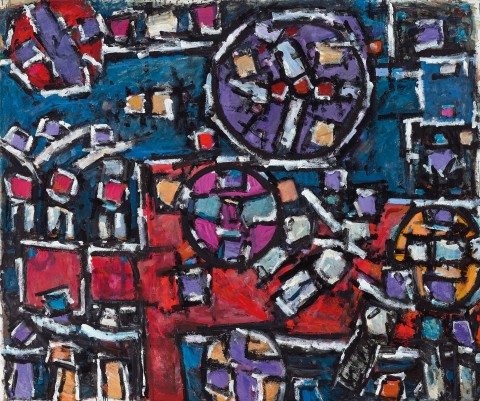UNTITLED, c.1981
ROGER KEMP
synthetic polymer paint on canvas
208.0 x 250.0 cm
bears inscription verso: COVENTRY
Estate of the artist, Melbourne, until 2000
Eastgate & Holst, Melbourne
Private collection, Perth, acquired from the above in 2005
Director’s Choice, Eastgate & Holst, Melbourne, September, 2005
Abstraction 21, Charles Nodrum Gallery, Melbourne, 16 October - 20 November 2021, cat. 7
Makin, J., ‘Stars blossom in spring’, Herard Sun, 19 September 2005, p. 96 (illus.)
‘Whether the forms are the circle and square or the cruciform image… the cycle of Kemp’s experience returns again and again to the same states of being. Energy and rhythm are everywhere apparent and their passage into structural form provides one of the enduring formal and iconographic themes of his art.’1
Grounded in geometry and mediated by gesture, Roger Kemp’s bold abstract paintings are unique within late twentieth century Australian art, revealing both the singular vision and expressive hand of their maker. Kemp’s purpose also set him apart. There is no narrative in his work, no obvious figuration or representational aim. He sought instead, to express a deeper meaning through his art, a personal perspective ‘that alluded to the timeless and universal, a means to articulate his experience of a higher truth.’2
Dedicating himself to painting full-time from 1966, the 1970s was a critical decade in Kemp’s career, which saw his practice widely acknowledged and celebrated. His work was included in the inaugural Sydney Biennale in 1973, he was awarded an OBE for services to Australian art in 1977, and in 1978, a group of works was acquired for the developing national collection. By this time, Kemp had also established a strong relationship with Marianne Baillieu, who ran Realities Gallery in Melbourne, and she energetically championed his work, presenting it in successful commercial exhibitions and placing it in important private and public collections. Slowed down by a stroke in 1980, Kemp had to relearn the use and control of his body, but his motivation and creative drive remained strong. Initially working on a small scale, he was soon producing vast mural-sized paintings which had become such a signature element of his oeuvre during the previous decade. Further accolades and recognition were to follow, including a commission (completed in 1984) to produce a suite of large-scale tapestries for the Great Hall at the National Gallery of Victoria. Hanging against towering bluestone walls beneath Leonard French’s stained-glass ceiling, the Kemp tapestries were well known to visitors to the gallery for decades to come.
Created around 1981, this untitled painting exemplifies the expressive dynamism and graphic power of Kemp’s work. His familiar palette of dusty blues and purples is combined here with vibrant shades of red, orange and pink, which are arranged, mosaic-like, into a series of geometric shapes. A red cruciform in the lower left of the canvas and four floating circles dominate the composition, but jostling against smaller, less structured blocks of colour and areas of expressive, gestural painting in the background, they are held in a finely balanced equilibrium. Black and white painted lines define the forms and animate the image, emphasising the feeling of movement across the painting’s surface which vibrates with a palpable sense of energy. The scale on which Kemp worked demanded that painting was a very physical act and, beginning with a preparatory sketch to outline the composition, he then worked freely, as this painting shows, ‘without traces of mannerism, artifice or guile… There was no apparent struggle, no erasures or revisions.’3
1. McCaughey, P., Roger Kemp: Cycles and Directions 1935-1975, Monash University, Melbourne, 1978, n.p.
2. Heathcote, C., A Quiet Revolution: The Rise of Australian Art 1946 – 1968, Text Publishing, Melbourne, 1995, p. 7
3. See Heathcote, C., The Art of Roger Kemp, Macmillan, Melbourne, 2007, p. 140
KIRSTY GRANT
